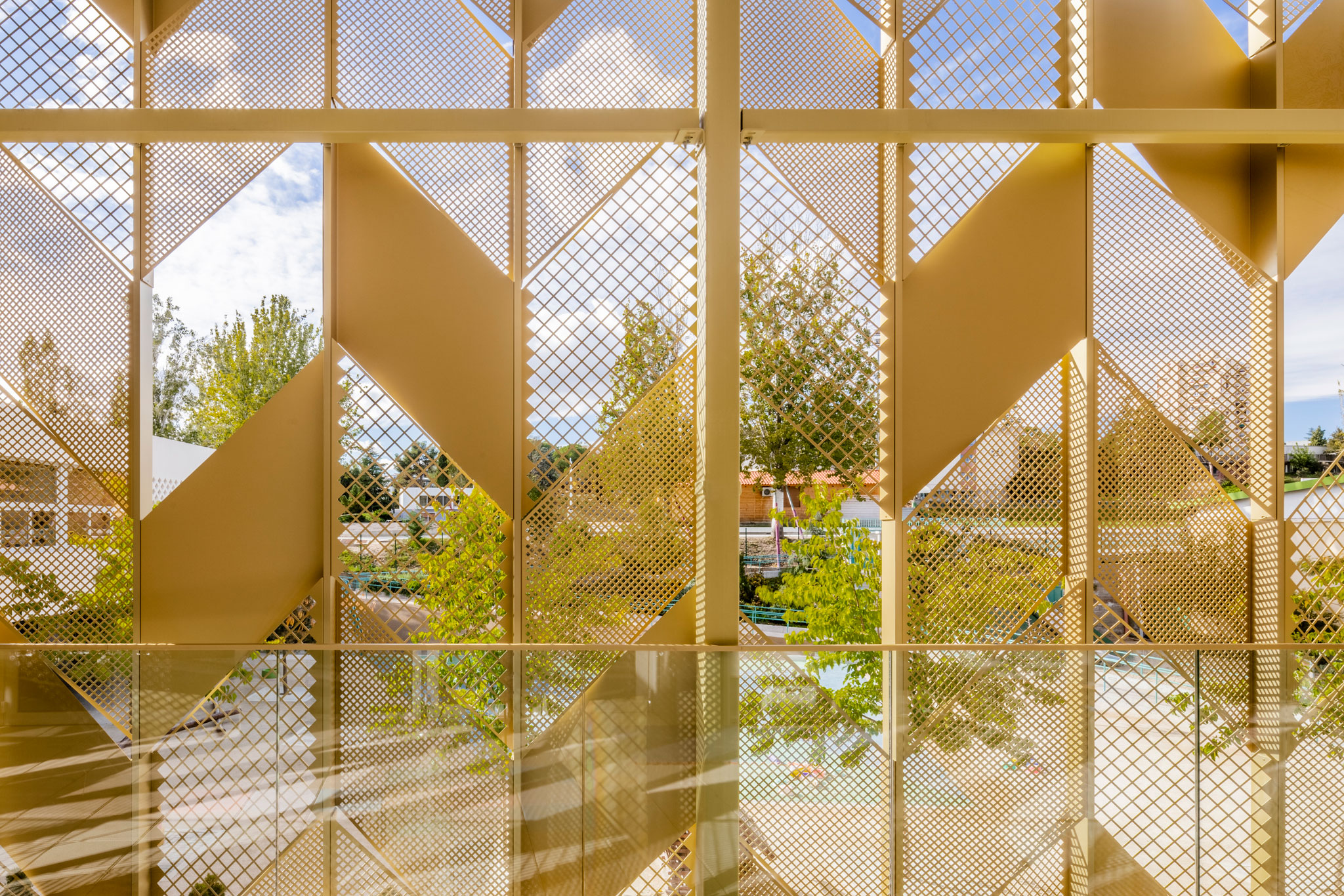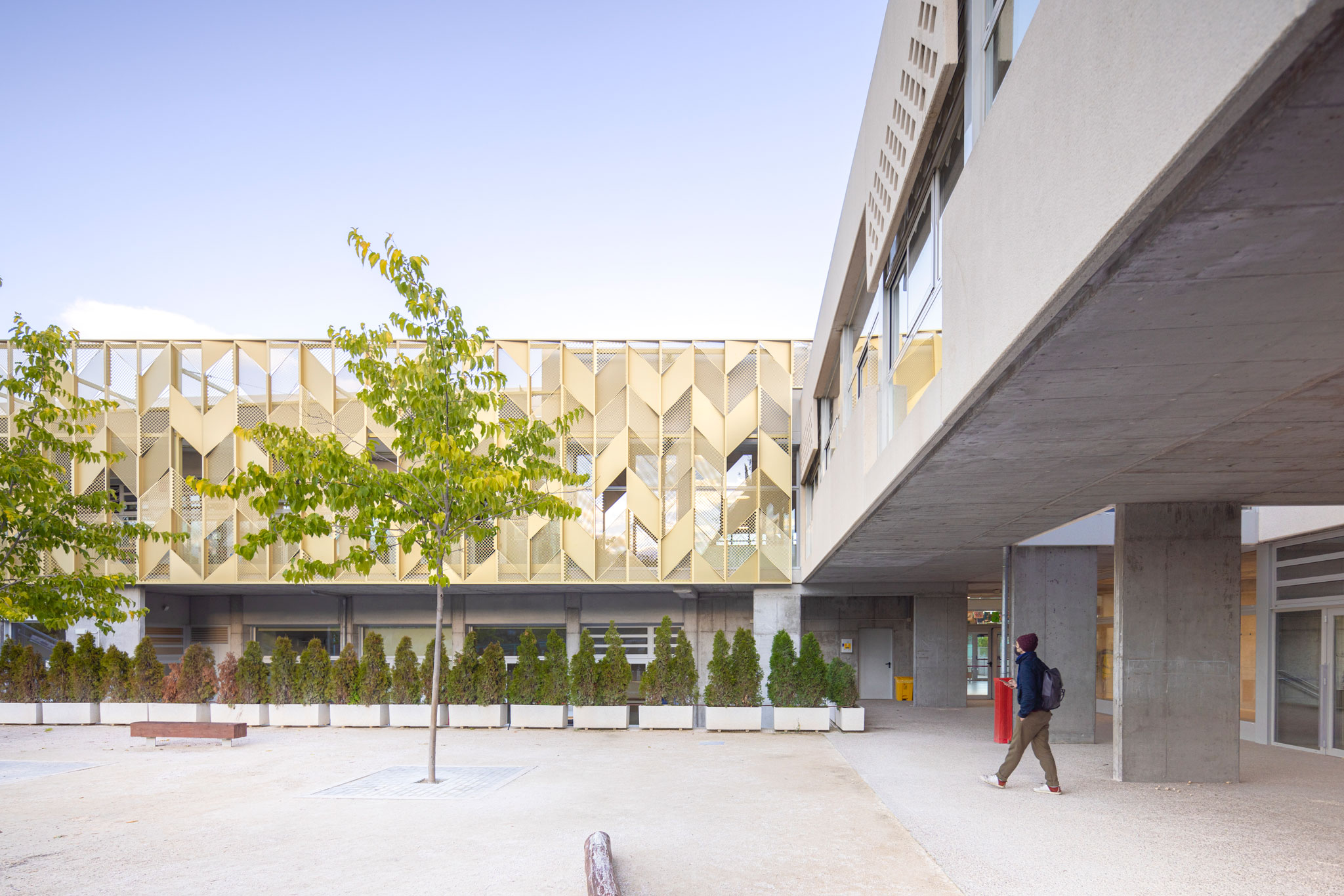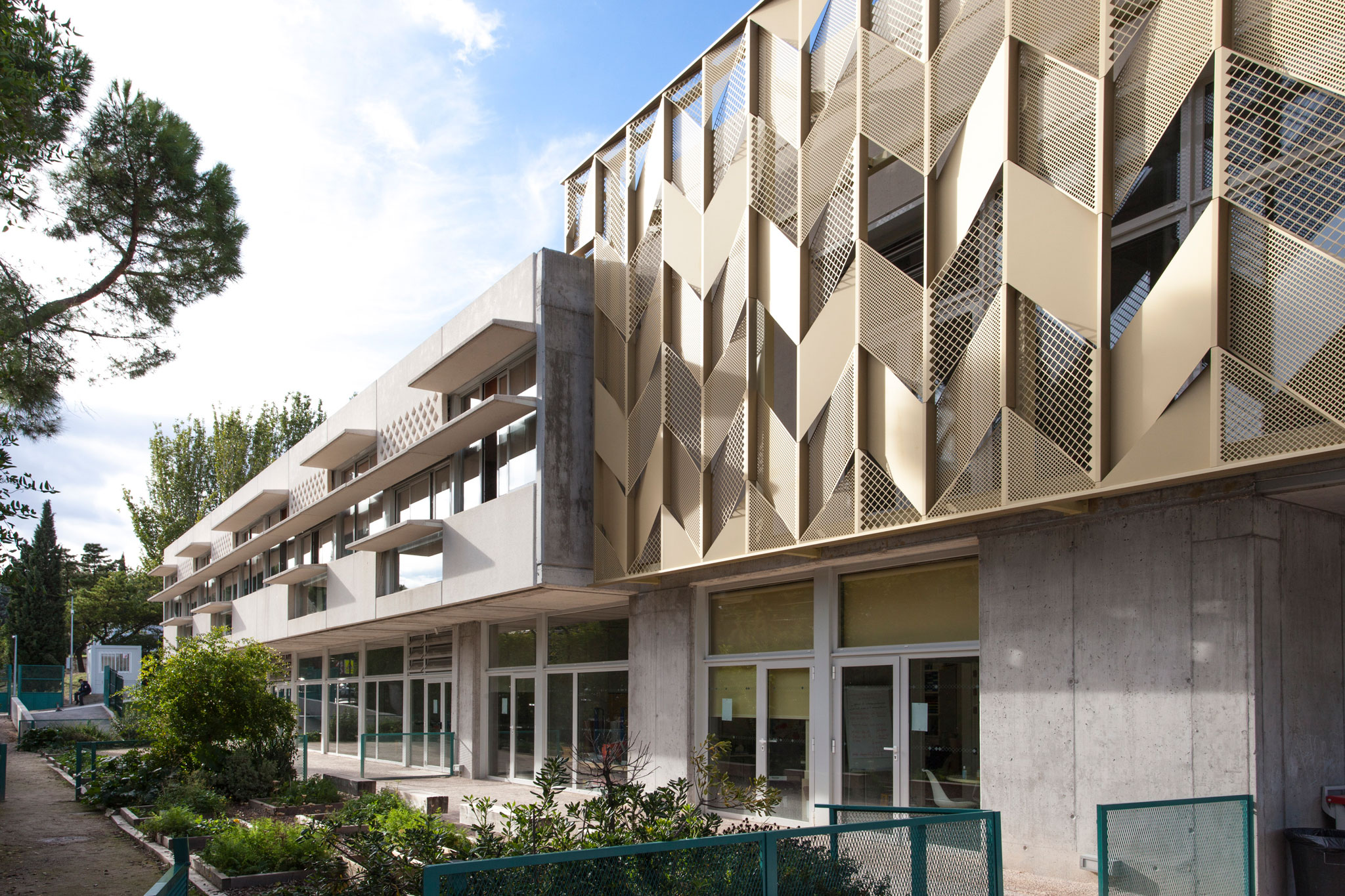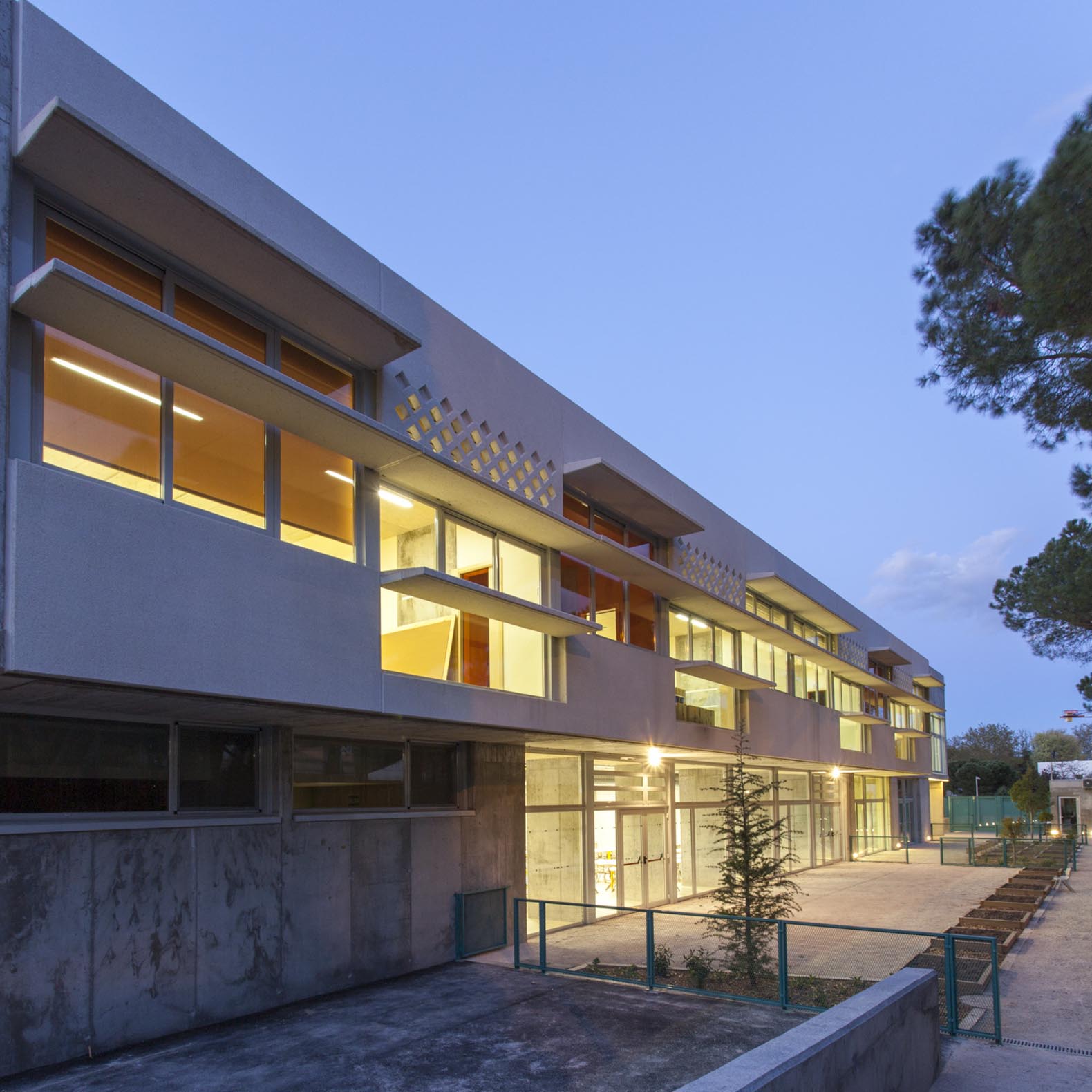Special relevance is the interest in materiality, the origin and shape of the materials that step on, touch, and breathe, that is, the perception of textures, (Montessori method and the discovery of textures through the materials of their toys, 1912), to allow child development, experimenting with the finishes that surround the classroom space.
Another of the important aspects developed in the project was the treatment of the facades, the control of natural light and the search for thermal comfort, which differentiates the orientations that face south or north, giving a different material response. The new thermal envelope of the nursery school configures the central volume and constitutes the identity element of the building, within the Liceo complex. It is made up of light modular scales of anodized aluminium with an assembly similar to a machine, which allowed the intervention to be carried out during the summer months when the centre for its activity.

New first-cycle nursery school and outdoor spaces of the French Lyceum by Ale Estudio and b-ground arquitectura. Photograph by Juan Sepúlveda.

New first-cycle nursery school and outdoor spaces of the French Lyceum by Ale Estudio and b-ground arquitectura. Photograph by Juan Sepúlveda.
Project description by Ale Estudio, b-ground arquitectura and Des Clics et des Calques
Children's school of the French Lyceum of Madrid
It is about awakening sensitivity to the natural environment from the childhood phase, experiences, and enjoyment, are the best way to learn and to know the natural environment, which ultimately leads us to respect and value it.
We have worked both in the interior space and in the playgrounds, using materials and their textures to achieve sustainable comfort.
This building is planned from the beginning with the objective of being an efficient building that meets the standards of the HQE (High-Quality Environmental) certificate, whose objective is to consider the overall performance of the building and evaluate its impact from the beginning of the construction process until the decision. awareness and didactic playful participation of the user.
Historically, the classroom has been a hierarchical, rigid, unidirectional and autonomous space, which inhibited any possibility of freedom and movement with elements such as a raised platform for the teacher, and a seat associated with a desk... This type of communication Non-verbal through the environment has a direct impact on the child's way of learning. The cultural producer, María Acaso proposes connecting pleasure with learning. How to do it through the environment? (2010).
We understand the classroom as a transformable dynamic space, associated with tranquillity, and concentration, but also improvisational play, which allows introducing various activities and connecting with other classrooms to enable collaborative teaching projects.

New first-cycle nursery school and outdoor spaces of the French Lyceum by Ale Estudio and b-ground arquitectura. Photograph by Ojo Vivo Foto.
Natural materiality
The Montessori method already proposed the discovery of textures through the materials of his toys (1912).
Touch, so important in the early stages of child development, allows experimenting with the finishes that surround the classroom space. Through this sense, the discovery of different materials and textures is stimulated.
Through these factors, we introduce interest in materiality, the origin and shape of the materials that step on, touch, and breathe. Materials on which they jump, climb, gather, run or sleep.
The classroom flooring is made up of linoleum surfaces, a flooring of natural origin that forms a smooth, soft and soft surface for carrying out daily activities. On the other hand, the surfaces that function as acoustic absorbers are made up of panels made of very fine fibres of wood wool from coniferous trees. The birch wood furniture and the exposed concrete screens and the vegetal space captured in the patios complete the palette of textures in the classrooms.

New first-cycle nursery school and outdoor spaces of the French Lyceum by Ale Estudio and b-ground arquitectura. Photograph by Juan Sepúlveda.
A friendly relationship with the environment
Understanding the green campus in which the infant school is integrated, it is fragmented into three low volumes to adapt its scale to the children while maintaining formal coherence with the rest of the centre's teaching buildings, from which it takes the modulation in facades of classrooms that allows simplifying the prefabricated processes of the work.
The central volume of the school is configured by an envelope of counterbalanced aluminium scales that constitutes the identity element of the building, within the Liceo complex. This skin generates a vibrant façade of reflections and shadows that transforms throughout the day and relates to the nearby treetops. At the same time, it creates intermediate spaces that allow the expansion of activities from the centre to the outside.
The greatest direct connection with the exterior of the different areas of the project has been sought, thus the library and multipurpose room unfold in the exterior environment but are protected from the sun that configures a textile cover and the lattice. The classrooms are directly connected to patios or exterior corridors and orchards. A system of small courtyards has also been introduced in relation to the classrooms, which seeks to introduce the plant world into them and facilitate the perception of seasonal changes. In the classroom, the use of coloured paving materials similar to the compacted earth in the patios also seeks to materially link these two complementary areas in the development of the child's learning.

New first-cycle nursery school and outdoor spaces of the French Lyceum by Ale Estudio and b-ground arquitectura. Photograph by Ojo Vivo Foto.
Thermal comfort
Through sight we discover colours and light; essential elements to generate happy and comfortable spaces. Achieving a comfortable space throughout the day during which the light, sunshine, wind and temperature change entails a series of actions in which we consider it interesting to involve boys and girls. In addition, it would serve as a useful resource to explain the use of mechanisms that improve thermal comfort - such as blinds, curtains, fans, and grilles, to explain the systems. The idea of abandoning mechanical systems that generate cold/heat on a daily basis, which produce energy expenditure and which, however, lack reflection on the part of the little ones, is reinforced.
In this sense, in the French Lyceum, both air conditioning and ventilation systems have been proposed that allow comfort to be achieved while minimizing expense. A natural ventilation system consisting of revolving windows, grilles and ducts that are manually activated has been proposed. The use of ceiling fans and blinds that help regulate the temperature according to the time of day and the season is proposed.
With all this, it has been tried to involve both teachers and children in active and playful pedagogical participation in these processes.



















































